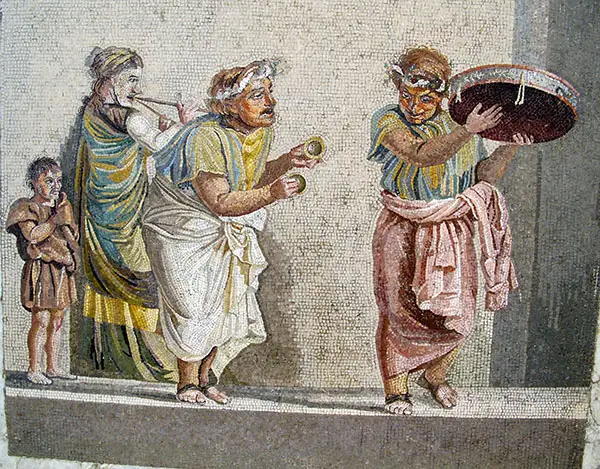Roman Dance
During Ancient Roman times, dancing was considered a form of entertainment.
Like other things that happened in Ancient Rome, dance was something that was influenced by the Ancient Greeks.

3rd Century
During the third century B.C.E., people that were wealthy in Ancient Rome loved to dance and they were interested in dance to the point where they would enroll their children into dancing school.
Dancing was considered a form of entertainment and if someone was skilled at dancing and was really good at it, they were considered corrupted and the Romans would look down on them.
Greek Dancing
The Greek slaves knew how to dance and when they became under the rule of the Romans, they would dance for the Romans in order to entertain them.
Later, the Greeks set up a dance school and they began to teach the Ancient Romans how to dance.
Bellicrepa
One dance that the Romans had that was considered a native dance was called the Bellicrepa. This dance was made by the founder Romulus. This dance was taught to Ancient Roman soldiers.
Dancing
People that were lower class in Ancient Rome were the ones that would dance. They would dance to entertain themselves and they would dance to entertain others.
People that were wealthy or high classed people would not dance or participate in any type of dancing.
Skilled Dancing
Most of the people in Ancient Rome that were skilled dancers and were the best dancers were normally from Spain or from Greece.
When Nero was the Emperor, dancing was the most popular and then later when the Christian Church was in charge, dancing became banned from theaters.
Etruscan
Some of the dances were inspired by Greek dancing and this was called Etruscan.
Pyrrhic
Another Greek dance was called pyrrhic which was popular by the Romans.
The priests would dance these dances and would call them war dances and would carry a shield with them that was called a religious shield.
They would carry a religious shield in their left hand and have a staff that was sacred in their right hand and they would wear a full set of armor while they danced.
The priests did this to honor the military and to dance if people in the area were unable to have children. This was considered a fertility dance.
Miming
Miming was another thing that was considered a dance. This was popular in the 1st Century B.C. and this was called pantomimes.
Mimes were done with dancing and music and the actors were not allowed to be in the mimes of antiquity.
Many of these dances were done to honor mythology and the gods and goddesses and the dances would be done with singers and with musical instruments.
Stories
There were dancers that would come together to narrate different stories and signs. The dancers would do different signs and gestures while they danced across the stage.
The signs and gestures were done by professional dancers and they were hard to learn.
The Dead
Many Ancient Romans believed that dancing pleased the dead. It weas considered to be a sign of joy and future and when the dancers moved into a new home, they would dance around it with music.
Funerals
Dancing was often done at funerals and would be done with music and musical instruments.
Most of the time the dancing would happen and people would play lyres, castanets and other brass or steel instruments.
Temple of Mars
There were many dances that Salli, the Priest of Mars, made. They would dance on the first day or March and they would sing and say hymns. They would then have a large banquet after the dancing was finished.
Facts About Ancient Roman Dance:
- Some of the dancers were favored by the wealthy and they would hire these specific people to dance at their banquets.
- Domitian and Nero were amongst other emperors who loved to hire dancers.
- Augustine that that pantomimes were evil and that they would harm Rome.
- Early Christians thought that dancing was evil.
- Scipio Aemilianus, a Roman aristocrat, wanted to shut down dancing schools.
What Did You Learn?
- Who founded Ancient Roman dance? Romulus founded Ancient Roman dance.
- Was dancing seen as an upper-class thing? People in higher classes would not participate in dancing and the lower-class dancers were not considered popular.
- Where did dancing happen in Ancient Rome? Dancing happened at funerals, weddings and other celebrations.
- What was another kind of dancing where the dancers would go on stage and not speak? This type of dancing was called pantomime.
- Who thought music was harmful? Augustine and the early Christians.



